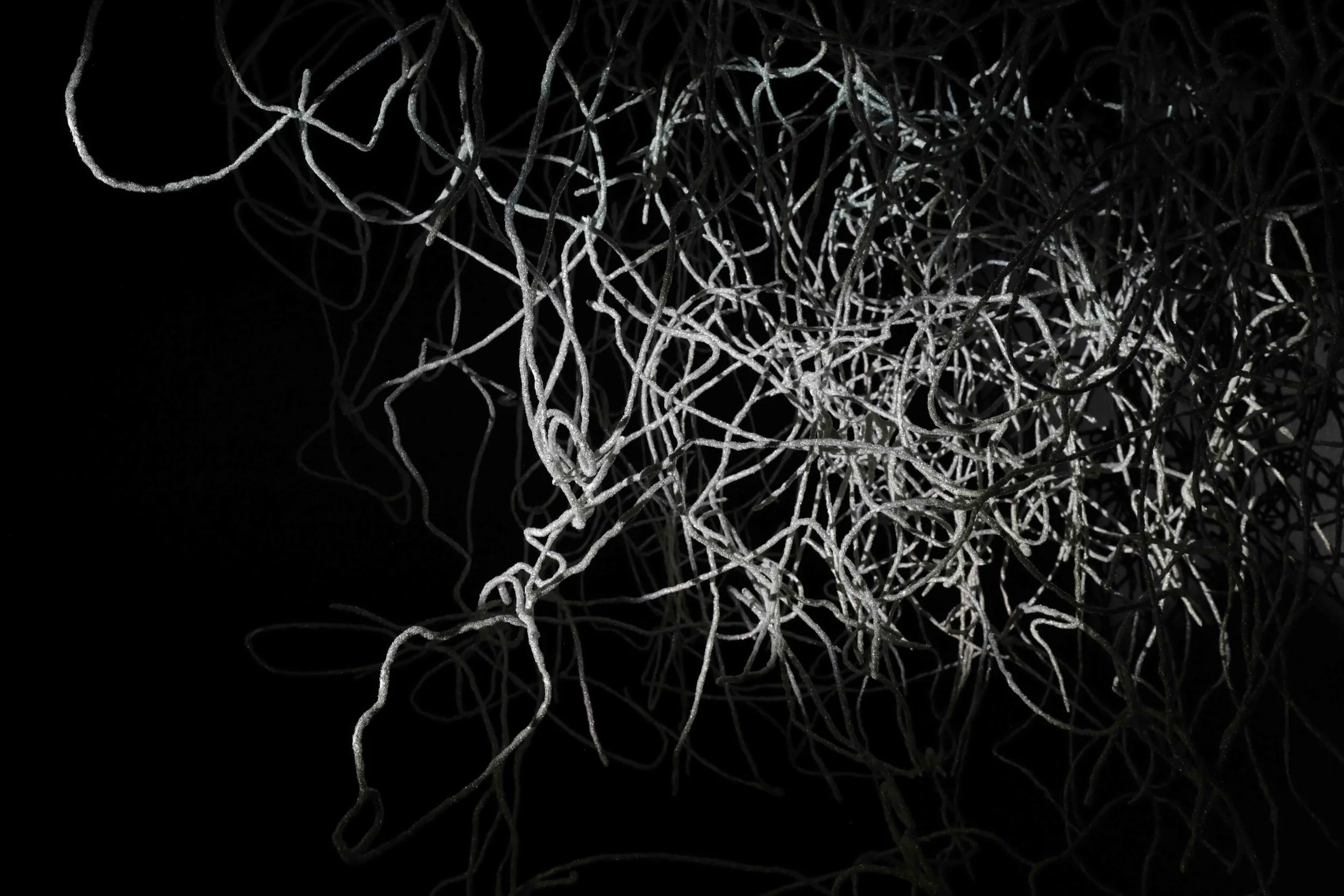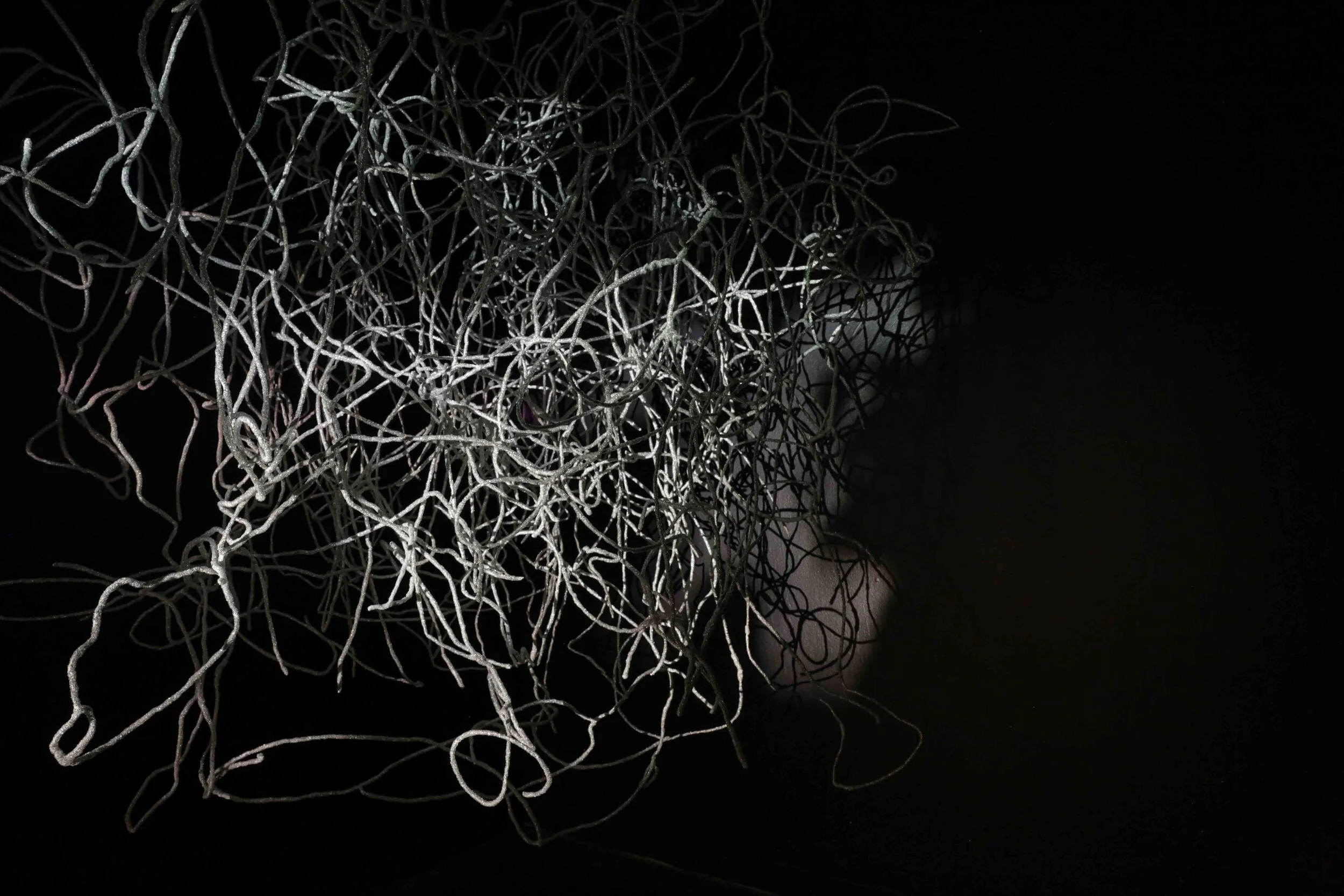Between Now and Now: Mary Smull on Jessica Jane Julius
Between Now and Now
Mary Smull on Jessica Jane Julius
Jessica Jane Julius’ installation, Between Now and Now, is created primarily from millions of tiny glass reflector spheres, traditionally manufactured for use in highway markings. These spheres shine brightly when exposed to light in an otherwise dark environment, creating a luminous effect. Julius’ installation visualizes the notion of complex systems and networks that exist in the world around us. Mary Smull’s essay playfully illuminates the artist’s themes through the context of the chandelier. Her essay builds a relational connection through chance encounters with various manifestations of the crystalline lighting fixture, drawing connections through the fleeting rainbow refraction of a single prismatic crystal to the pomp and circumstance of the Philadelphia Mormon Temple’s opulent crystal chandelier.
2020 programming is supported by Added Velocity which is administered by Temple Contemporary at Tyler School of Art and Architecture, Temple University and funded by the William Penn Foundation.
Last year, my husband brought home a single chandelier crystal that he found at a secondhand shop. He hung it in the front window of our Philly rowhouse, dangling it from a fluorescent yellow cord. There’s a time of year–late fall to midwinter–when the sun hits that window at just the right angle in the morning, and the crystal throws dots of rainbow-colored light all over our living room. It lasts only a few minutes each day.
* * *
Shortly after the Mormon Temple in Philadelphia was completed–but before it was consecrated–it was possible to get a tour of the entire building. For non-Mormons, this was a rare opportunity to see an otherwise “off-limits” place of worship.
It’s an unusual environment for those of us raised in more garden-variety Christian churches. From the outside, the Mormon Temple resembles a cathedral, a huge rectangular building, several stories high with stained glass windows on the outside and a steeple. On the inside, it’s not anything like a cathedral. The stained glass windows do not shed their colored light on a vast sanctuary and the congregants gathered there. Instead, they shine into hallways. The interior of the building is split up into several floors. Mazes of inner windowless rooms are available on each floor, for small groups of worshippers to gather.
On the top floor of the Temple there are two very special rooms–one for men, another for women–where Mormons can experience what they consider to be the closest possible environment to heaven on earth. It is indeed a very fancy room. There are French Renaissance-style armchairs to sit in, and you can lean back far enough in your chair to gaze in contemplation at the largest chandelier I have ever seen.
* * *
My son’s preschool asked all the children to bring in “100 of something”–anything–for show and tell, to celebrate their 100th day of school on February 7th. This is a chore for the parents, especially the parents who (like me) try to stretch for something a little more exciting than “100 puzzle pieces” or “100 pennies.” After suggesting many possible items that could be gathered and brought in that number–macaroni? sequins? paper clips?–my son announced that he wanted to bring 100 lights to school. I grabbed a box of Christmas lights and sent him on his way.
* * *
I’ve made a living as a bookkeeper for most of my adult life, and while I have worked with many different kinds of businesses over the last 20 years, most of my clients have been restaurants. My job requires frequent visits to the “backstage” areas of restaurants, spaces the patrons never see–offices, basements, storage areas. These visits are brief–just a few minutes every week, to pick up bills and drop off old paperwork.
I operate a bit like a ghost in these environments. I don’t really belong there. I’m not a cast member of the show that everyone else is putting on each day. I haunt these places, sometimes slipping in and out of the place unseen, often spooking new employees with my presence. I smile and nod, not usually introducing myself (I’m terrible with names and even sometimes with faces–likely as not I should know this person already and I don’t want to embarrass myself). I quickly file old paperwork, pick up new paperwork.
Today, by my feet, among the scattered piles of random “props” that seem to end up in every restaurant office, lies a tiny chandelier in a cardboard box full of other junk. It’s lying right next to a greasy-looking plastic bottle about the same size–the kind with a pointy red spout, usually used to dispense dressing at a salad bar. The chandelier’s silvery, refracting surface and miniature circular crystals look dirty, dim, and gray. It looks ashamed to be seen next to that too-white, too-bright, slimy-looking bottle.
* * *
I walk into a room painted black. There is a sculpture, a glittering tangled mass of thick branch-like reflective wires, hanging in one corner. It’s larger than I am, but not huge–perhaps a friend and I could reach our hands around it and touch one another’s fingertips. It’s placement feels slightly off-center. There are flashing lights reflecting off the surface of the sculpture from a projector in the corner of the room.
From far away, it drips with disappointment–too static, too small, too off-center, neither here nor there. But up close–and especially from underneath–every so often the projection catches just the right angle on the reflective surface, and it glows magically, the light prismatic and delicate. The projection changes, the fragile and fleeting light disappears, and I lie on the floor, waiting for its return.
Mary Smull is an artist, writer, and curator living in Philadelphia, PA. She merges object and action in a practice centered around conceptual and textile processes to expose the diversity of attitudes toward labor and the complex relationship between art history and domestic craft.
Jessica Jane Julius has been dedicated to the arts for more than fifteen years as an artist, educator, collaborator, and performer. She exhibits large scale installations, objects, and imagery that reflect on the current "culture of fear" in our society, making work that evaluates where fear is manifested and where it is cultivated. She is the co-founder of the artists’ collective and performance group The Burnt Asphalt Family, which produces collaborative participatory works. They have performed at prestigious venues across the country including The Studio at Corning Museum of Glass, The Chrysler Museum, and Urban Glass. Her mixed media works have been exhibited nationally including the Philadelphia Museum of Art, The Museum of American Glass, NJ, and Pilchuck Gallery in Seattle, Washington. Her work has been selected numerous times for publication in New Glass Review, and she has been awarded residencies at The Creative Glass Center of America in Millville, New Jersey, and The Museum of Glass in Tacoma, Washington. She is on the board of the Glass Arts Society and was recently appointed to the Executive Committee as the Vice President. She served as Interim Program Head of Glass at Tyler School of Art and University of the Arts, and has taught at RIT, Pilchuck Glass School, Urban Glass, and The Studio at Corning Museum of Glass. She earned her BFA in Glass at Tyler School of Art and her MFA in Glass at Rochester Institute of Technology. She is currently an Assistant Professor in Glass at Tyler School of Art, Temple University, and lives in Philadelphia with her husband and son.





